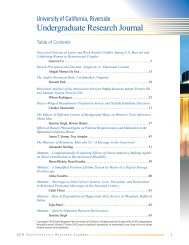UC Riverside Undergraduate Research Journal
UC Riverside Undergraduate Research Journal
UC Riverside Undergraduate Research Journal
Create successful ePaper yourself
Turn your PDF publications into a flip-book with our unique Google optimized e-Paper software.
Zero Waste Biodiesel: Using Glycerin And Biomass To Create Renewable Energy<br />
Sean Brady<br />
not possible due to limited resources, mainly having used<br />
all available oxygen and squibs. (Update: As of the time of<br />
publication, access to a functional lab calorimeter has been<br />
obtained, and ongoing research is underway. Initial results<br />
proved our efforts worthwhile, coming in at 15.4, 15.6, and<br />
15.2 kJ/g and displaying a respectable error rate of only<br />
10% for our ad-hoc apparatus. These results will be part of a<br />
larger report to be published at a later date.)<br />
Figure 4. Presented are the components used to make the biomass<br />
glycerin waste pellets.<br />
raw pellet is transferred into the mold, a short length of<br />
PVC with one end sealed. The diameter of the PVC pipe is<br />
12.5 mm, and its length is four inches. The mold helps the<br />
pellet retain its cylindrical shape while a short metal rod,<br />
slightly smaller than the PVC internal diameter, is inserted<br />
into the open end of the mold to compress the pellet.<br />
Pressure was applied by hand, approximately 250 psi for<br />
15 seconds. This pressure not only reduced the pellet size,<br />
but also encouraged the glycerin to permeate the materials<br />
and form a single firm unit. It should be noted that this form<br />
of production is only used in initial laboratory experiments<br />
and actual commercial production will of course be large<br />
scale and automated. Figure 4 shows the components that<br />
were used in the bench scale process.<br />
A key element of this project is energy estimation of<br />
solid matter via calorific testing. Without a laboratory-quality<br />
bomb calorimeter, this test was conducted by combusting<br />
the material in an aluminum ‘boat,’ floating in water, in a<br />
well-insulated container. 9 While conducting this process, it<br />
was found that additional oxygen was needed for sufficient<br />
combustion to occur. The reaction eventually consumes the<br />
solid matter, and the temperature change experienced in the<br />
water is recorded and placed into the specific heat equation<br />
to find the energy content for the mass of the pellet. After<br />
multiple runs of failed calorimeter results due to accidental<br />
combustion of the container, wetting of the mixture, and<br />
failure of the squib to ignite, a single somewhat accurate<br />
quantitative estimate of the energy content of the solid was<br />
obtained, and is included in Table 1. Additional tests were<br />
Error Analysis<br />
In considering possible sources of error in this<br />
design, the only area of concern lies with our ad-hoc<br />
calorimeter and its ability to estimate energy content.<br />
If a proper calorimeter was available, the data, and our<br />
estimates derived thereof, would be much more reliable.<br />
Additional deviation would arise from variations inherent<br />
in the waste biomass, but given the medium (RDF pellets)<br />
the energy output is expected to vary slightly unit to unit.<br />
Additional testing to determine the exact variation to be<br />
expected will be performed once an adequate calorimeter<br />
is obtained.<br />
Results<br />
The energy values for glycerin waste pellets and<br />
competing energy sources are shown in Table 1, showing<br />
that theoretically and experimentally, the glycerin waste<br />
pellet is a very suitable source in replacing or supplementing<br />
low end coal and RDFs.<br />
Discussion<br />
Economical Impacts<br />
The economic aspects of this project are perhaps<br />
the most readily understood and appreciated. The fact that<br />
biodiesel is less expensive to produce than petroleumbased<br />
diesel is a significant contributor to biodiesel<br />
emerging popularity. However, those costs do not include<br />
costs associated with storage or disposal of waste glycerin,<br />
a consideration which is going to demand significant<br />
attention as biodiesel production increases. Laboratorybased<br />
biodiesel production on a small scale can cost less<br />
than a $1 a gallon; however, in a large scale biodiesel plant,<br />
with associated licensing and fees, production can cost<br />
$1.13 - $2.60 depending on the quality of the materials used.<br />
With waste oil (used cooking oil) the cost is expected to not<br />
exceed $1.58. 10 As discussed, the solid fuel pellets created<br />
8 <strong>UC</strong>R Un d e r g r a d u a t e Re s e a r c h Jo u r n a l














